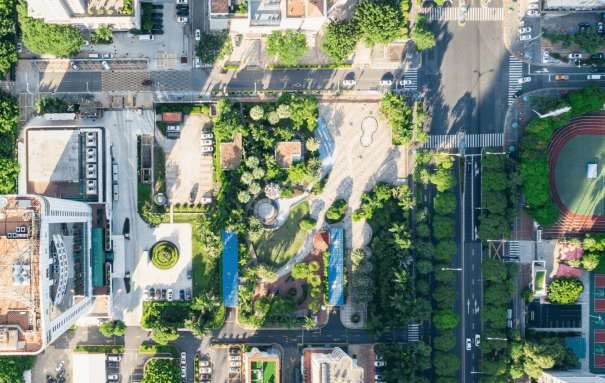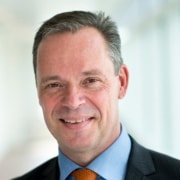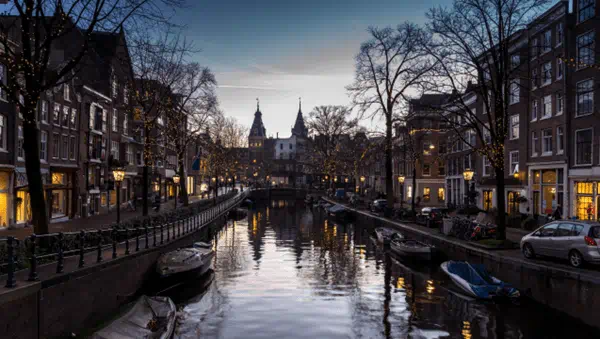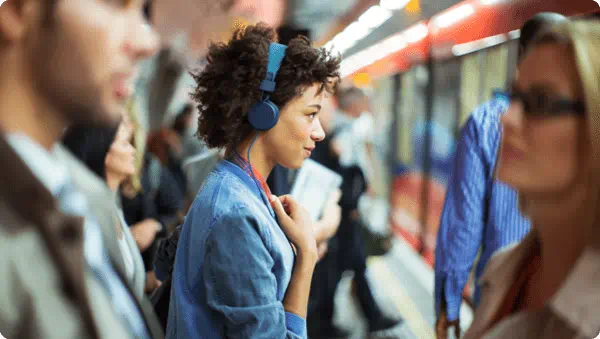00:05
Davion Ford
Welcome to Better Cities by Design, a podcast brought to you by Arcadis, where we talk to changemakers who are working to make our cities better places for people to live, work and play. I'm your host, Davion Ford. This week we're headed back to the city of Rotterdam in the Netherlands, and we're talking to Harry Verhaar, Head of Global Public and Government Affairs at Signify, a global leader in lighting solutions and sustainability. We talk with Harry about the role of street lighting in Rotterdam, and cities in general, and the outsized impact lighting can have on carbon emissions.
00:50
Davion Ford
The city of Rotterdam is arguably the Netherlands most modern looking city having been rebuilt in the second half of the 20th century, after being largely destroyed in the Second World War. The city bills itself as a hub for entrepreneurship, innovation, and sustainability. And this all makes good sense for a number of reasons. Rotterdam is home to the largest port in all of Europe, making it the economic engine of the Netherlands. But like much of the Netherlands, Rotterdam is highly susceptible to the impacts of climate change, specifically rising sea levels. In fact, as much as 90% of Rotterdam is below sea level. Now luckily for people living in Rotterdam, the Dutch are world famous for their prowess when it comes to managing water and keeping their waterlogged country dry and therefore habitable. For now, Rotterdam sits safely behind an intricate network of dams and dikes, which keeps the water at bay. But the ever intensifying impacts of climate change mean that Rotterdamers, as they're called, can't afford to rest on their laurels, and that's why the city has ambitious climate action plans. This includes adaptation plans aimed at protecting the city from climate impacts, like strengthening its flood and storm surge protections, but it also includes mitigation or significantly reducing the carbon emissions that are contributing to climate change. For more on this, here's Arcadis’ Global Director of Energy Transition Carolien Gehrels.
02:25
Carolien Gehrels
Well in the city itself, Rotterdam is very busy with district heating, with carbon capture storage for the big industries in the Port of Rotterdam, and the Port of Rotterdam is a global player when it comes to hydrogen. Import, export, and carbon capture storage is also very important there because the industry is there.
02:47
Davion Ford
One area where Rotterdam has made significant strides in reducing carbon emissions is lighting. You may not realize it, but lighting is a significant source of energy consumption and also carbon emissions. According to the US Department of Energy, lighting accounts for 15% of global electricity consumption, and 5% of worldwide greenhouse gas emissions. A wholesale shift to LED lighting instead of old school light bulbs could reduce CO2 emissions by 800 million metric tons per year, which would be the equivalent of shutting down more than 680 coal fired power plants. This is because LED lights consume up to 80% less energy than traditional light bulbs. To learn more about all of this we've invited to the show Harry Verhaar, Head of Global Public and Government Affairs at the global lighting company Signify.
03:50
Davion Ford
Hello Harry, welcome to the show.
03:52
Harry Verhaar
Hi, Davion. Thanks for inviting me and looking forward to the discussion.
03:56
Davion Ford
So the city of Rotterdam here in the Netherlands has several efforts underway related to street lighting. Can you tell us a bit about this and the role Signify is playing in these efforts?
04:07
Harry Verhaar
Yeah, so Rotterdam is a great example. It's also where a few things come together. So before LEDs were available, lighting was analog and you really had to go out and look if your light points were still working or not and then come back in the morning with replacement products. But then also for a city like Rotterdam, this meant quite an effort, but also through the inefficiency compared to today of that technology, it also meant massive carbon emissions. Electricity costs, certainly now today, prices have gone up. So Rotterdam has made a big climate initiative around the aim to reduce CO2 emissions by 50% between 1990 and 2025 and become carbon neutral in 2050. And a big part of their program is on LED lighting. So even looking at the street lighting, they are saving us on average you can say 50% of energy and CO2 emissions by switching to LED lighting. But also they recognize, so we've seen that also from citizens back, that the quality of light is better, so people feel safer. Things are more visible. So also actually you can recognize the color of your car. So some of us will remember then, yeah, parking lots in the dark and all the cars look the same. But also they feel, yeah, they feel safer. It's more socially inviting. And so, and actually, so maybe one remark to that. So while Rotterdam aims to become neutral in 2050, they are in the midst of a program to switch all their street lighting to LED by 2025. So that's really great work they're doing.
05:39
Davion Ford
I’d like to build on the point that you're talking about there around safety, because I do think that this is the thing that some of us can sometimes take for granted in cities, the really important role that having light and being able to see what's going on around you plays, and not just a sense of feeling safe, but the reality of being safe. So can you talk a bit about the role of lighting in a city like Rotterdam and keeping people safe?
06:07
Harry Verhaar
Yeah, so that's really interesting. So a few years ago, the World Council on City Data, which is a global city organization that is headquartered in Toronto in Canada, they did a research looking to cities that had already switched their street lighting to connected LED. And they found how they looked at Los Angeles, Buenos Aires and a number of other cities in total, I think there were 10. And they confirmed the energy saving was between 50 and 70%, which was good. I think for LA there was even $10 million dollars per year, so not small money. But also what they found is that street crime could potentially go down by 21%. So that is robberies and burglaries, assaults and burglaries, but also the nighttime traffic accidents, which is where most traffic accidents occur, is down by 30%. And technically, a technical term is that with LED, so you're better at vertical recognition. So simply said, you see better. You can imagine when you see better, you make less mistakes and also people are less naughty, so fewer accidents and less crime. And those are things that are next to the savings and let's say the whole wider climate and energy benefits that come to it. Now, there are things that I think any city mayor is of course eager to provide for the citizens.
07:28
Davion Ford
Yeah, I think that those figures that you've just brought to bear really, really bring to life, the fact that lighting and all that it brings and getting lighting, right in cities, it isn't just about the situation around the electricity use and sustainability, but it's a myriad of impacts that it has. That said, that sustainability piece is critically important, as you mentioned that what percentage of electricity spent lighting used to be. So when you look at a city like Rotterdam, what does that look like at a municipal level in terms of modernizing their lighting and the relationship to like carbon emissions?
08:09
Harry Verhaar
Yeah, so that's quite substantial. So the lighting sector is being seen as really proactive and in the frontend, all sectors need to change. And I think everything on climate efficiency, renewables electrification needs to double in speed. But then what is amazing is that where our business is 85% LED, still 50% of all installed light points in Europe are old technology, so tubes and bulbs. So there's a massive potential. And sometimes we use the European numbers. It would mean if Europe would switch, that would save 65 billion euro, so that's a lot. But also reduce 51 million tons of CO2. But what we then also do is we go down to company level, to household level and to city level, as you mentioned, Davion. And in a city as Rotterdam, that's a little over 600,000 inhabitants, would switch all of their public lighting. So basically street lighting, public offices and schools and architecture lighting, to LED, so they will be saving about 35 million euros.
09:09
Davion Ford
And that's on a yearly basis, right?
09:13
Harry Verhaar
That's on a yearly basis. And there's a second relevance to this because now with the energy crisis, we all become more aware that we need to electrify heating and transport. And I like numbers, I like modeling a bit. On average, households' electricity consumption in Europe is 3,400 kilowatt hours. But that is also exactly what an electric vehicle needs for 10,000 miles per year, which is the number that is being used. But also for heat pumps, depending on your house. So you will be tripling, you would need actually three times the electricity that normal households consume, if everybody would go electric on heating and transport. So if in Europe, and of course, well, I won't mention the European numbers now, but if a city as Rotterdam, then switches the lighting and they actually free up an amount of electricity that can help them provide heat pumps to about 30,000 households, but also about 30,000 electric vehicles could be charged with electricity that is no longer wasted on old lightning.
10:12
Davion Ford
That's fascinating. And I think really drives home that point that you've been making throughout of all of the myriad benefits to getting lighting, right, in cities. So we've heard quite a bit about that. But of course, Signify is, at its core, a consumer goods company, and you've developed lighting that's used in millions of homes around the world. And like any consumer goods company, that sustainability point around your own operations is a really critical issue, in particular, to issues like waste. So I was thinking about your business model, or the business model of any consumer goods company. And it occurred to me that, I'll just oversimplify what you guys do by saying that you're selling light bulbs, I know that that's not the sum total of what Signify does. But for our purposes here, from a sales standpoint, maybe it wouldn't be the best thing for your company to have those bulbs last too long, right? You want to make additional sales. So I guess my question is, how are you guys looking at your business model around sales? Relative to the topic of sustainability and waste and circularity? What's your view on this?
11:20
Harry Verhaar
Yeah, so we're definitely not in the business of selling more stuff. So my deep personal belief, but it's also what we do as a company is that we are moving from selling more, let's say for more is better to a model where better is best. In essence, how then sustainability is just another word for innovation. So this is also an innovation race. And the value is not in selling more bulbs, but in improving people's lives and doing what is right for the quality of our living environment. So when you look at innovation, yeah, we are constantly making LEDs more efficient and thereby, then there's an interest in upgrading your lighting. We're also looking at, let's say we're also working on making our products modular because quite often you're stuck with old technology, imagine if a T Ford would have lasted 100 years, well, still, nobody would like to drive it. The T Ford today would be massively inefficient. So then, so that is also why we're making our product modular. So that when software or when efficiency has progressed, then city mayors, but also business owners, but also at home and in supermarkets, you can upgrade that part or that module of lighting and it will make it, yeah, that will upgrade to the latest standards. So we are also moving to 3D printed luminaires, which can actually be tailored on a software platform, and it's more or less overnight. And because lighting is connected, there's also an important aspect there. We launched a few years ago, and we saw that LEDs are in a way you could say they are chips. That's all the light points get an IP address. And then the city mayor and city hall, but also companies had the facility management, they can look from a dashboard, just on your computer, what works, how much it consumes. So you can also move to performance-based, let's say to service-based contracts. And then indeed, and those you can see, okay, when is it time again to upgrade, to renew, so that overall you have least cost and least environmental impact. And this is also important that coming back to the safety discussion in cities. Have you seen how some cities that are switching off their lights? Well, of course you should switch it off when you don't need it, but they're switching off some lights at night because of the whole energy crisis and the cost of electricity. But then, yeah, if you switch it off, let's say from 10 in the evening till four in the morning you save 50%. Now, if you transition to LED, you already save 50% and you can keep the lights on. But if you then make them smart, and that is what Rotterdam does, how they include tele-management and present detection, you can indeed, you can move down to, let's say up to 92% savings while maintaining safety and security, which is what citizens want because you don't want crime rates to increase by switching off the lights. So in that sense, we are constantly innovating. And we see, you could say also that tackling climate change is an innovation race to the future. We just need to step on the gas and increase the speed with which those new solutions are being used that are cleaner, that are cheaper, and that provide social benefits that matter a lot to people.
14:20
Davion Ford
Harry, I'd like to close out our discussion by asking you to talk about the future of lighting. You already spoke about light points and cities being used to collect other types of data. Maybe you can touch upon that a bit more. I remember reading as well around things around air pollution detection and there are other things that can be done from those light points. But what else do you see on the horizon in cities with utilizing those light points?
14:48
Harry Verhaar
Yeah, two quick things and then indeed to close off a very cool innovation. So two quick things. So then lighting is digital, but also means that we include multi-sensors. So for instance, and again, Rotterdam, but also Los Angeles and other cities, they're then using their streetlights to triangulate sounds. And so then the sensor can detect if it was a gunshot or a car, let's say a car accident. So gunshots may be more likely in Los Angeles than in Rotterdam. But then still, based on the type of sound that is detected, automatically the police or the ambulance can be alerted. And also air quality can be measured with that. So they're all things relevant for a city. But then also on food, so there's a big increase in agriculture lighting. We see more and more weather anomalies affecting harvest, we see countries that have a climate that is not friendly for year round food production service, either vertical farming, where we grow food, but also where it's consumed. And fish farming. So did you know, by the way, that more than 50% of the fish that we eat is from fish farming? And actually when you bring lights down in the and they eat on site. So when they are fed, they rush to the surface. Part of the food get lost. They get nervous. But also in the top five meters, you got sea lice. So then also part of your fish is no longer. But they get ill. You can't consume them. So when you drop down lights on a string and you can switch them on, then it's dinner time for fish. So all kinds of cool things. But the coolest, I think, of all that you refer to is Li-Fi. And we're all used to wireless communication with Wi-Fi, but we see that the radio part of the spectrum is getting congested. And in the next seven years, there will be a 10-time more demand for wireless communication, and it's just not possible. And then the light part of the spectrum is completely empty. So we then superimposing data on light waves, and you can communicate with the speed of light. And this is important for autonomous driving. But also in areas where you don't want electromagnetic waves from, let's say from the, from Wi-Fi. In airplanes, you can watch high definition movies, say without the pilot being concerned about electromagnetic interference with navigation. In factories, say where there's also a lot of movement and machinery, you can safely transfer data also to keep your employees safe. But also banks, hospitals. In a hospital, headlight doesn't go through walls. So a doctor can look at patient data without, yeah, transmitting this through walls. And did you know that the Pentagon doesn't have Wi-Fi because they are concerned about snooping and hacking on those waves. So we see with Li-Fi, yeah, that has a huge potential. Also in the whole digital environment, however, we're going to need a lot of wireless communication, while at the same time being green, digital and efficient. So in a sense, you could see then, yeah, you really see the light, however, you don't take it for granted. And also there, we're looking forward to working further in the future with cities like Rotterdam, because it is also in cities that the war on climate will be won or lost. This is also a lot of the funding flows and a lot of the action and the good jobs are. So yeah, lighting will remain to be relevant and there's still a lot happening in the future.
18:04
Davion Ford
Harry, thank you so much for the fascinating conversation. Learned a whole lot about what lighting means to all of us living in cities and what it could mean for the future. Appreciate your time.
18:14
Harry Verhaar
Thank you, Davion. It was a pleasure.
18:16
Davion Ford
That's all for this episode of the show. A big thank you to Harry Verhaar from Signify for joining us. Stay tuned for future episodes as we continue to bring changemakers to the table who are driving progress in urban development. And if you haven't done it already, please subscribe and check out our other episodes. I'm Davion Ford and you've been listening to Better Cities by Design. A podcast brought to you by Arcadis, the world's leading company delivering sustainable design engineering and consultancy solutions for natural and built assets. You can learn more by visiting our website arcadis.com or by following us on LinkedIn or Facebook. Stay curious, get inspired, and remember the future belongs to those who dare to make a difference in the cities we call home.






